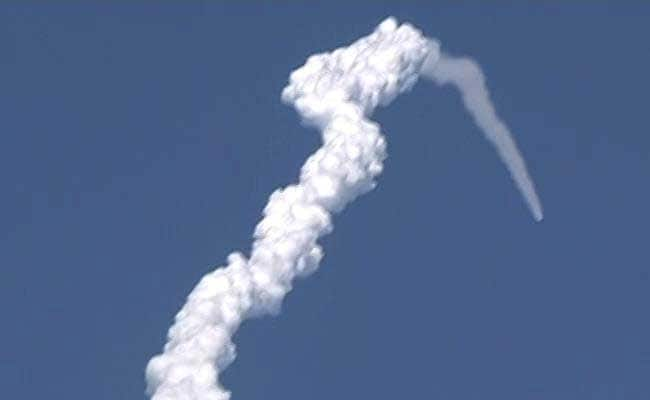ISRO's South Asia Satellite, Atop 50-Meter Rocket, Lifts Off: 10 Points
India launched PM Narendra Modi's gift - South Asia communications satellite, made under a Rs. 450-crore project.
1. About 50 of India's best space engineers and scientists of the Indian Space Research Organisation (ISRO) monitored lift off. It will be known in about 15 minutes whether the launch was successful.
2. The 2,230-kg satellite - it weighs as much as four full grown elephants - will provide telecommunication links between India, Nepal, Bhutan, Bangladesh, Maldives, Sri Lanka and Afghanistan.
3. Leaders of the six beneficiary countries will video-conference their comments after the launch.
4. The satellite will help the countries communicate better during disasters and could help establish a hotline between them. It will also help in telemedicine and education.
5. The South Asia Satellite, which uses a new propulsion system, was built over three years. Its mission life is 12 years. The GSLV rocket that launched it weighs 414 kg and is 50 meters tall. This is the GSLV's 11th flight.
6. The satellite has 12 Ku Band transponders -- devices that help in communication. Each nation will get access to at least one transponder. India said it was ready to help them with the ground infrastructure.
7. Prime Minister Narendra Modi has said the satellite embodies the "spirit of Sabka Saath, Sabka Vikas... inclusive development for all." That mantra, PM Modi said in his radio address Mann Ki Baat, was not confined to India alone. "It applies to the global context too. And very specially to our neighbouring countries," he said.
8. The facilities of the satellite, the Prime Minister said, "will go a long way in addressing South Asia's economic and developmental priorities".
9. PM Modi had, after taking office in 2014, asked scientists at ISRO to develop a SAARC satellite as a gift dedicated to neighbouring countries.
10. Pakistan was the only SAARC member that opted out of the project, saying it has its "own space programme". Pakistan has five satellites but lacks heavy duty launchers and satellite fabrication facilities.
(Source : ndtv.com)
ISRO's South Asia Communications Satellite lifts off from Sriharikota, Andhra Pradesh
SRIHARIKOTA (ANDHRA PRADESH): The Geosynchronous Satellite Launch Vehicle or GSLV lifted off at 4.57 this evening from Sriharikota in Andhra Pradesh, carrying a 450-crore communications satellite that Prime Minister Narendra Modi has gifted to six South Asian neighbours. "The team of scientists who worked hard for the successful launch of South Asia Satellite. We are very proud of them," the PM has tweeted. About 50 of India's best space engineers and scientists of the Indian Space Research Organisation (ISRO) are monitoring the launch.
A 10-point-guide to the South Asia Satellite's launch:
1. About 50 of India's best space engineers and scientists of the Indian Space Research Organisation (ISRO) monitored lift off. It will be known in about 15 minutes whether the launch was successful.
2. The 2,230-kg satellite - it weighs as much as four full grown elephants - will provide telecommunication links between India, Nepal, Bhutan, Bangladesh, Maldives, Sri Lanka and Afghanistan.
3. Leaders of the six beneficiary countries will video-conference their comments after the launch.
4. The satellite will help the countries communicate better during disasters and could help establish a hotline between them. It will also help in telemedicine and education.
5. The South Asia Satellite, which uses a new propulsion system, was built over three years. Its mission life is 12 years. The GSLV rocket that launched it weighs 414 kg and is 50 meters tall. This is the GSLV's 11th flight.
6. The satellite has 12 Ku Band transponders -- devices that help in communication. Each nation will get access to at least one transponder. India said it was ready to help them with the ground infrastructure.
7. Prime Minister Narendra Modi has said the satellite embodies the "spirit of Sabka Saath, Sabka Vikas... inclusive development for all." That mantra, PM Modi said in his radio address Mann Ki Baat, was not confined to India alone. "It applies to the global context too. And very specially to our neighbouring countries," he said.
8. The facilities of the satellite, the Prime Minister said, "will go a long way in addressing South Asia's economic and developmental priorities".
9. PM Modi had, after taking office in 2014, asked scientists at ISRO to develop a SAARC satellite as a gift dedicated to neighbouring countries.
10. Pakistan was the only SAARC member that opted out of the project, saying it has its "own space programme". Pakistan has five satellites but lacks heavy duty launchers and satellite fabrication facilities.
(Source : ndtv.com)




Post A Comment
No comments :